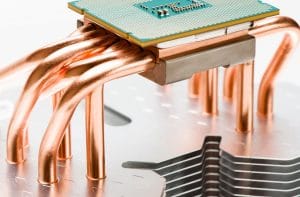 The advanced state of today’s technology was made possible by countless innovations, improvements, and iterations of different technological aspects. While each of these aspects has been vital in their own right, one of the most significant advancements has been in the realm of electrical thermal management. This is the process of keeping electrical components and the enclosures they’re housed in properly cooled and preventing the waste heat from causing damage. The ability to achieve electrical cooling in a highly efficient manner, and using increasingly more versatile heat transfer methods, has been crucial to the advancements of most forms of technology.
The advanced state of today’s technology was made possible by countless innovations, improvements, and iterations of different technological aspects. While each of these aspects has been vital in their own right, one of the most significant advancements has been in the realm of electrical thermal management. This is the process of keeping electrical components and the enclosures they’re housed in properly cooled and preventing the waste heat from causing damage. The ability to achieve electrical cooling in a highly efficient manner, and using increasingly more versatile heat transfer methods, has been crucial to the advancements of most forms of technology.
Making electrical cooling more versatile
Making electrical thermal management more versatile was imperative for making high-performance technologies viable. Traditional cooling solutions, like air conditioners and air compressors, hindered the ability of technology designers to create more powerful designs. Such solutions were inherently cumbersome due to their high energy needs and constant need for maintenance. To address this challenge, technology designers began utilizing more natural and easily manageable methods of transferring electrical waste heat, such as liquid cooling. As custom thermal solutions like heat exchangers became more popular, utilizing methods like liquid cooling became much more cost-effective.
A shift toward eco-friendly thermal management
Versatility has always been vital to the continuous advancement of electrical cooling. However, it hasn’t been the only key to this advancement; as with most other processes, electrical thermal management has also become a strong focus for greener, more eco-friendly solutions. This wasn’t always possible, as solutions like air conditioning and air compressing didn’t leave much room for greener processes. However, more modern solutions, like heat exchangers, are designed to utilize natural heat transfer methods, such as phase-change cooling, rather than mechanically chilling and circulating air. This dramatically reduces the amount of energy companies need to facilitate high-performance thermal management – a key focus in the shift toward greater eco-friendliness.
The nature of streamlined thermal management
The idea that technology can be more effectively and efficiently cooled with less complex electrical cooling solutions might seem contradictory. However, companies that have embraced the change have enjoyed several significant advantages by streamlining the ways they approach thermal management. For example, using phase-change cooling, certain heat exchangers can bring the high-performance capabilities of liquid cooling to everything from standard manufacturing processes to more specialized and innovative applications. For more information about heat exchangers and the modernization of thermal management, call Noren Thermal Solutions in Taylor, TX, at 866-936-6736.







